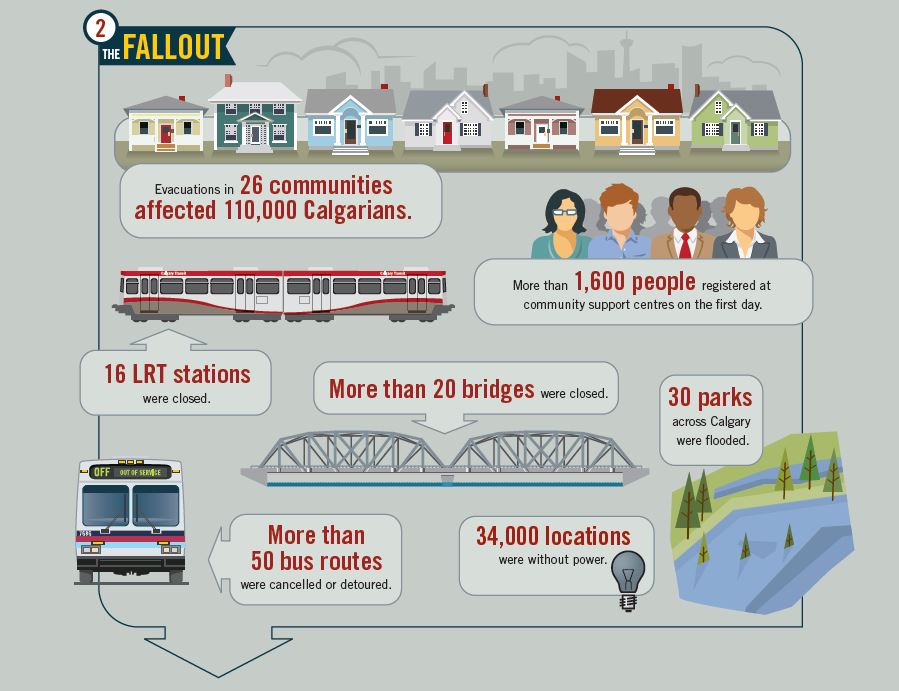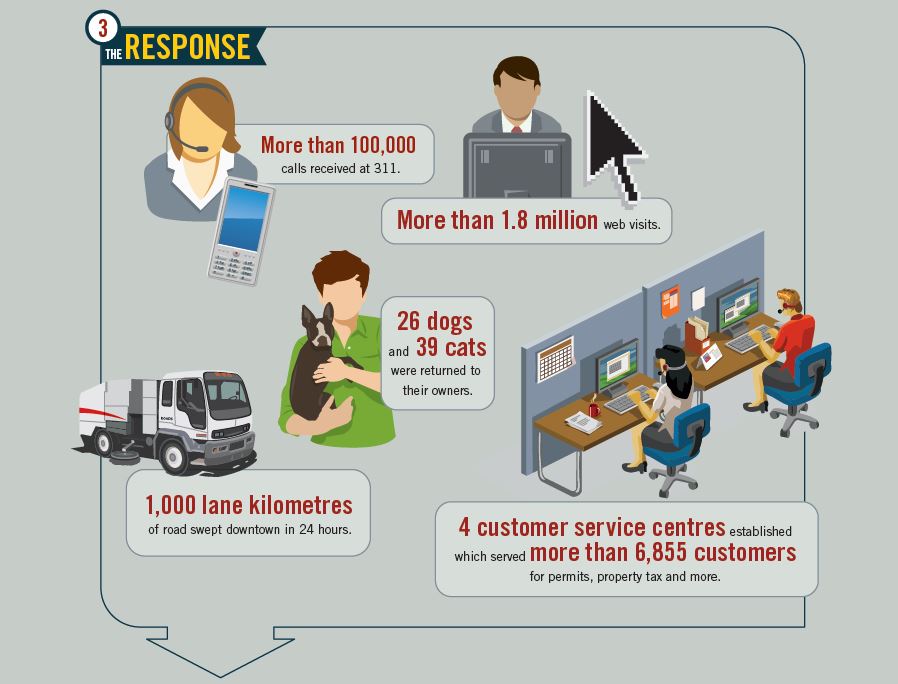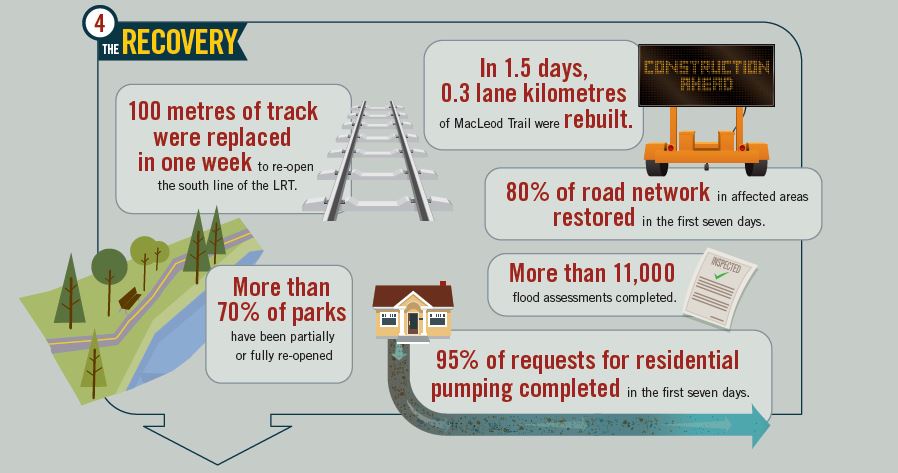A timeline of events and warnings leading up to the flood
Prior to the major flooding on June 19th and 20th, Alberta Environment reported higher than average snowpack in the Eastern Rocky Mountains for the month of May, raising further concern for flooding potential in the South Saskatchewan River Basin [1]. Nonetheless, concerns remained low until above average amounts of rain began to fall across the Southern Alberta region in early June.
The enormous amounts of rainfall (approximately 270 mm) that accumulated in Southern Alberta between June 19th and 20th were the result of unique circumstances that kept heavy rainfall weather systems above the Eastern Rocky Mountain range for days [2]. While heavy rainfall was predicted by meteorologists well before flooding occurred, the degree and extent of high flood waters could not be predetermined,as a result warnings about the danger of flooding were delayed.
On the morning of June 19th, 2013, residents of the community Cougar Creek in Canmore, Alberta were evacuated from their homes. This event was followed by the declaration of 32 States of Local Emergency (SOLE) across the Province in the City of Calgary, High River, Siksika First Nation, Drumheller, Medicine Hat and the Turner Valley region. Following the initial shock and damage created by the flood, were days of emergency management and response, preceded by months of recovery and reclamation with progress still to be made.
Timeline of Emergencies
There were numerous Flood Advisories and Warnings for southern Alberta issued between June 19th and June 29th. For a complete list of all advisories and warnings visit the AESRD June 2013 archive.
|
June 11, 2013 |
Hanging Stone River breeches banks and Fort McMurray declares a state of emergency. Alberta Health Services issues a boil water advisory for Fort McMurray[3]. |
|
June 20, 2013 |
2:42am Flood Watch issued for Highwood and Sheep River. High streamflow advisories issued for Bow River and Tributaries, Elbow River, Oldman River Basin, Red Deer River Basin, North Saskatchewan River Basin, Athabasca River Basin [4]. 6:45am Flood Warning was issued for Canmore. Residents were advised to take appropriate measures to avoid flood damage. 9:54am Critical Alert-Flash Flood warning issued. Rapid flooding in M.D of Foothills and residents warned to seek higher ground and shelter. 3:27pm Dam overflow alert in Municipal District of Willow Creek issued. Residents warned to protect themselves and livestock. Water Treatment Plant in Black Diamond shut down due to water safety concerns. State of Local Emergency (SOLE) declared in Calgary. The neighbourhoods of Beltline, Bonnybrook, Bowness, Bridgeland Industrial Area, Chinatown/Eau Claire, Cliff Bungalow, Deer Run, Discovery Ridge, Downtown/East Village, Elbow Park, Erlton, Inglewood, Hillhurst, Mission, Montgomery, Quarry Park, Rideau, Riverbed, Riverdale, Roxbro, Stanley Park/Elboya, Sunnyside, Victoria Park, Westmount, Windsor Park are asked to evacuate immediately [5]. |
|
June 22, 2013
|
Boil water advisory issued for East Siksika Community water system. Boil water order issued for Town of Canmore [6]. City of Calgary issued a press release stating water quality in Calgary remained “good” but asked residents to limit water use [7]. |
|
June 23, 2013 |
Boil water advisory issued for Siksika First Nation, Exshaw, Lake Louise, High River, Harvie Heights, MD of Big Horn and Kananaskis [8]. |
|
June 24, 2013 |
Alberta Health Services issued boil water advisory for hamlet of Veinerville due to damaged water pump in Medicine Hat [9]. |
|
June 27, 2013
|
Flood warning Alert ended in parts of southern Alberta. |
|
June 28, 2013
|
Calgary still under SOLE[10]. |
|
July 10, 2013 |
Safe drinking water restored for much of High River[11]. |
|
July 5, 2013 |
Alberta Emergency Alert issued a boil water advisory on July 5th effecting residents of the Hamlet of Cayley [12]. Boil water advisory for Canmore lifted [13]. |
|
July 19, 2013 |
Boil water advisory was lifted for the areas of Hampton Hills and Sunrise in Town of High River. |
|
September 12, 2013 |
Boil water advisory lifted for East Siksika Community water system. |
|
December, 2013 |
Boil water order still in effect for Kananaskis Field Station, Rafter Six Resort Waterworks System (Kananaskis), High River Waterworks System, Redwood Meadows Waterworks System (Bragg Creek), Siksika West Waterworks System (Siksika First Nation), Camp Chief Hector (Kananaskis), Canmore Waterworks System (West and East), Veinerville Waterworks System, Evan Thomas Valley Waterworks System (Kananaskis)[14]. |
|
January 29, 2014 |
State of Emergency in Turner Valley is terminated however water restrictions remain in place[15]. |
Sources
- Sosiak, Mia and Tamara Elliot. “Snowpack in backcountry could lead to flood risk in Alberta communities.” Global News. Accessed October 23, 2013.
- Sosiak, Mia and Tamara Elliot. “Snowpack in backcountry could lead to flood risk in Alberta communities.” Global News. Accessed October 23, 2013
- Staff. The Canadian Press. “Flooding timeline: A devastating, drenching June for Alberta”. Global News. Accessed October 23, 2013
- http://environment.alberta.ca/forecasting/advisories/130620a.pdf
- http://newsroom.calgary.ca/news/state-of-local-emergency-update-246972
- http://corp.epcor.com/News/2013/Pages/jun-22-canmore-boil-water-order.aspx
- http://newsroom.calgary.ca/news/state-of-local-emergency-water-246996
- The Huffington Post Alberta. (2013, June 23). Canmore Flooding Prompts Boil Water Advisory for Entire Town.
- http://www.bowislandcommentator.com/component/content/article/1995-boil-water-advisory-for-veinerville.html
- http://newsroom.calgary.ca/news/the-city-of-calgary-remains-in-247159
- http://alberta.ca/release.cfm?xID=34570CA7DC66C-F123-96C5-F5539296320BB839
- http://www.emergencyalert.alberta.ca/alerts/2013/07/1955.html
- http://calgary.ctvnews.ca/ahs-lifts-boil-water-advisory-for-canmore-1.1355733
- http://alberta.ca/Water-Infrastructure-Damage.cf
- http://www.turnervalley.ca/flood-recovery-information/
Share this Post:




